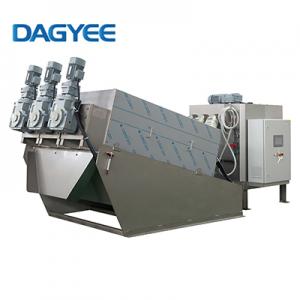How To Choose Multi-Media Filter
How To Choose Multi-Media Filter
Multi-Media Filter Description
Multi-media filter is a process of using one or several filter media to pass water with higher turbidity through a certain thickness of granular or non-granular materials under a certain pressure, thereby effectively removing suspended impurities and clarifying the water. The filter body mainly includes the following components: simplified version, water distribution component, support component, backwash air pipe, filter material, exhaust valve (external), etc.
Selection Basis Of Filter Material
1. It must have sufficient mechanical strength to avoid rapid wear and tear during the backwashing process;
2. Better chemical stability;
3. It does not contain harmful and toxic substances to human health, and does not contain substances that are harmful to production and affect production;
4. When selecting filter materials, try to use filter materials with large adsorption and interception capacity, high water production and good water quality.
In the filter material, the pebbles mainly play a supporting role. In the conventional configuration, the pebbles are divided into four specifications, and the paving method is from bottom to top, first large and then small. The common multi-media filters used in water treatment are: anthracite-quartz sand-magnetite filter, activated carbon-quartz sand-magnetite filter, activated carbon-quartz sand filter, quartz sand-ceramic filter Wait.

Main Considerations For Filter Layer Design
1. Different filter materials have a large density difference to ensure that no mixed layer phenomenon occurs after backwashing disturbance;
2. Select the filter material according to the purpose of the produced water;
3. The particle size of the lower filter material is smaller than that of the upper filter material to ensure the effectiveness and full utilization of the lower filter material. Take the three-layer filter bed as an example. The upper filter has the largest particle size and is composed of light filter materials with low density, such as anthracite and activated carbon; the middle filter has a medium particle size and a medium density, such as quartz sand; the lower filter has a particle size The smallest and densest heavy filter material, such as magnetite.
The upper filter material plays the role of coarse filtration, and the lower filter material plays the role of fine filtration, so that the role of the multi-media filter bed is fully brought into play, and the effluent water quality is obviously better than that of the single-layer filter bed.
Backwash Parameter Control And Determination
1. Expansion height: The backwash expansion rate is too large, the number of particles in the filter material per unit volume is reduced, and the chance of particle collision is also reduced, so it is not good for cleaning. Double-layer filter material, the expansion rate is 40-50%. The relatively stable filter layer has the following advantages: to ensure the stability of the filtered water quality and ensure the effect of backwashing;
2. Backwash water volume and pressure: backwash water intensity 40m3/(m2•h), backwash water pressure ≤0.15MPa;
3. Backwash air volume and pressure: backwash air intensity 15m/(m•h), reverse Washing air pressure ≤0.15MPa.
Air-Water Combined Backwash
1. Flush with air first, then backwash with water: First, lower the water level of the filter to 100mm above the surface of the filter layer, let in air for a few minutes, and then backwash with water. Suitable for filters with heavy surface pollution and light internal pollution. Note: The corresponding valve must be closed in place; otherwise, when the water level drops below the surface of the filter layer, the dirt will not be effectively discharged, but will move to the depth of the filter layer.
2. Air and water combined backwashing: Air and backwashing water are simultaneously fed from the bottom of the static filter layer to scrub the surface of the filter material; the backwashing water loosens the filter layer, which is conducive to the air scrubbing of the filter material. The expansion effects of backwash water and backwash air are superimposed on each other, and the effect is stronger than when they are performed alone. Note: The backwash pressure and strength of water are different from those of air. Pay attention to the sequence to prevent backwash water from entering the air duct.
3. After the air-water combined backwash is completed, stop entering the air, keep the backwash water at the same flow rate, and continue to rinse for 3-5 minutes to remove the air bubbles left in the filter bed.

Analysis Of Causes Of Filter Material Hardening
1. The dirt trapped on the surface of the filter layer cannot be effectively removed within a certain period of time. In the subsequent backwashing process, as the backwashing air is rubbed, the impurities will sink from the surface to the inside, and at the same time, they will sink into the filter. Extend within the filling depth until the entire filter fails.
Remarks: In actual operation, the phenomenon of uneven backwash air often occurs, mainly due to the perforation of the bottom air distribution pipe, the blockage or damage of the partial filter cap, or the deformation of the grid tube spacing.
2. The surface filter material of the filter layer has small particles, and there is less chance of collision with each other during backwashing, and it is not easy to clean. The attached sand particles are easy to form small mud balls, and they move to the depths as the mud balls grow up.
3. The oil contained in the raw water is trapped in the filter, and the remaining part is backwashed, which is the main factor that causes the filter material to harden. When to perform backwashing can be determined according to the water quality characteristics of the raw water and the effluent water quality requirements, using standards such as limited head loss, effluent water quality or filtration time.

Ashely
Wuxi Dajiang Environmental Technology Co., Ltd.
T:+86051085100889
M:+8613961861780
Whatsapp/Facebook : 8613961861780
www. wastewatermachinery.com




